Rajasthan Assembly Election
1952 Rajasthan Legislative Assembly Election Results
| 1952 Rajasthan Legislative Assembly Election Results | |||
|---|---|---|---|
| Sr. No. | Short Name | Full Name | Seats |
| 1 | INC | Indian National Congress | 82 |
| 2 | Independents | Independens | 35 |
| 3 | RRP | Akhil Bharatiya Ram Rajya Parishad | 24 |
| 4 | Socialist Party | Socialist Party | 7 |
| 5 | Others (Scheduled Caste Federation, CPI, etc.) | Others (Scheduled Caste Federation, CPI, etc.) | 12 |
| Total | 160 | ||
The 1952 election was held after the formation of Rajasthan by the merger of princely states.
The Indian National Congress (INC), riding on the popularity of the freedom movement and its national dominance, won 82 out of 160 seats, giving it a clear majority.
The Independents were surprisingly strong, winning 35 seats, reflecting local loyalties and the influence of former princely rulers in newly merged areas.
The Ram Rajya Parishad (RRP), a Hindu nationalist party formed by Swami Karpatri, secured 24 seats, making it the second-largest organized party.
Smaller parties like the Socialist Party and the Communist Party of India (CPI) had only marginal influence.
Tika Ram Paliwal (INC) became the first Chief Minister of Rajasthan in 1952. However, later in 1954, he was replaced by Mohan Lal Sukhadia, who went on to serve a record 17 years as CM (till 1971)
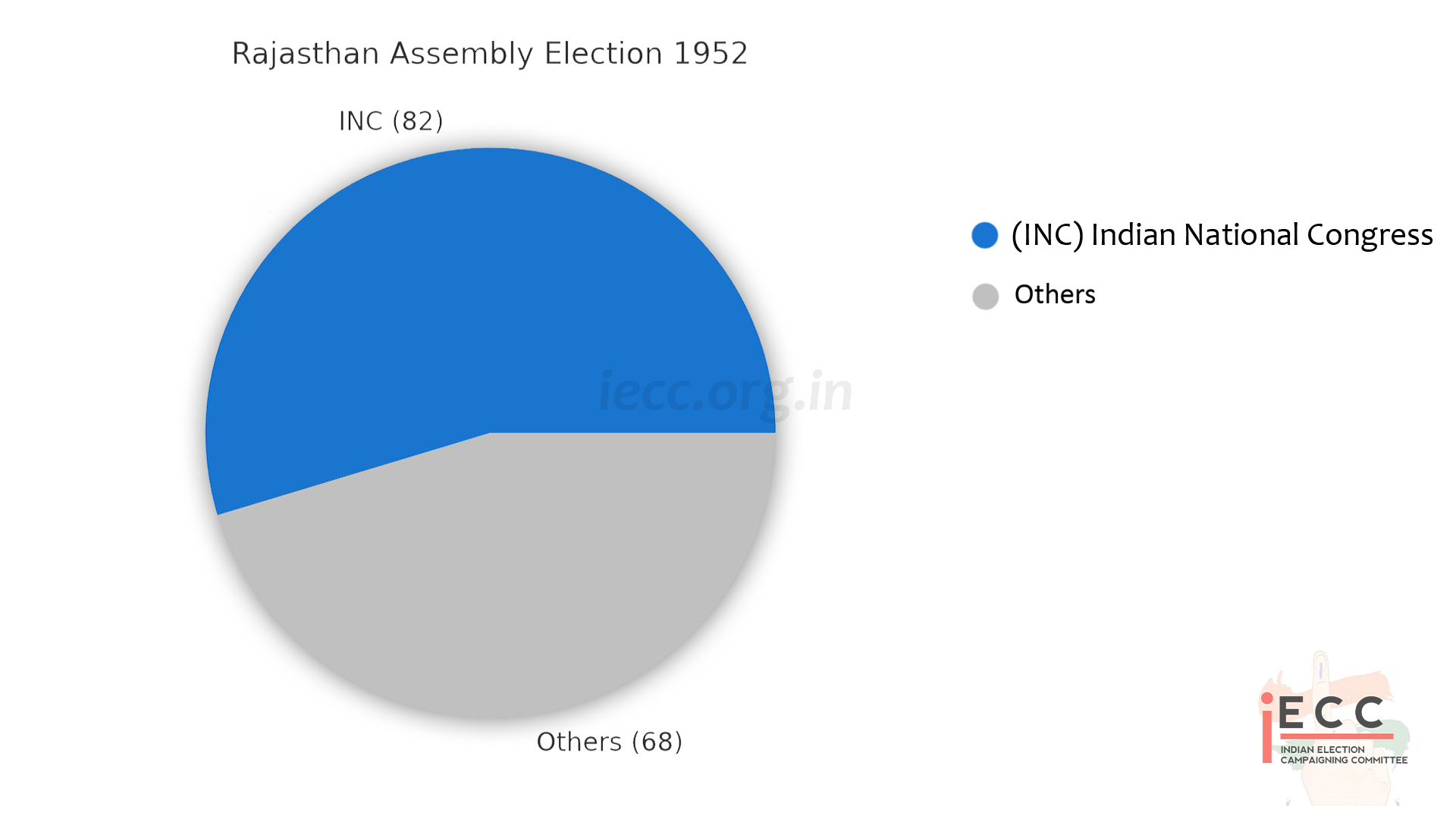
1957 Rajasthan Legislative Assembly Election Results
| 1957 Rajasthan Assembly Election Results | |||
|---|---|---|---|
| Sr. No. | Short Name | Full Name | Seats |
| 1 | INC | Indian National Congress | 119 |
| 2 | RRP | Ram Rajya Parishad | 16 |
| 3 | PSP | Praja Socialist Party | 13 |
| 4 | CPI | Communist Party of India | 4 |
| 5 | Independents | Independents | 24 |
| 6 | Others | Others | 0 |
| Total | 176 | ||
The 1957 elections consolidated the dominance of the Indian National Congress in Rajasthan.
Congress won 119 out of 176 seats, securing a comfortable majority and increasing its control compared to 1952.
The Ram Rajya Parishad (RRP), which had done well in 1952, declined to 16 seats as its appeal began to fade.
The Praja Socialist Party (PSP) made a mark with 13 seats, reflecting some support for socialist ideas in rural areas.
The Independents still held a sizeable 24 seats, showing the continued impact of local chieftains and ex-princely rulers.
After the election, Mohan Lal Sukhadia (INC) continued as Chief Minister of Rajasthan, having first assumed office in 1954.
Sukhadia went on to become the longest-serving Chief Minister in the history of Rajasthan (1954–1971), remembered for land reforms and strengthening education.

1962 Rajasthan Legislative Assembly Election Results
| 1962 Rajasthan Legislative Assembly Election Results | |||
|---|---|---|---|
| Sr. No. | Short Name | Full Name | Seats |
| 1 | INC | Indian National Congress | 90 |
| 2 | Swatantra Party | Swatantra Party | 36 |
| 3 | RRP | Ram Rajya Parishad | 10 |
| 4 | CPI | Communist Party of India | 5 |
| 5 | PSP | Praja Socialist Party | 11 |
| 6 | Independents | Independents | 24 |
| Total | 176 | ||
The 1962 election in Rajasthan was notable because the Congress lost ground, though it managed to just cross the majority mark with 90 seats (down from 119 in 1957).
The Swatantra Party, founded in 1959 by C. Rajagopalachari as a pro-market, anti-Congress party, emerged as a powerful new force, winning 36 seats and becoming the main opposition.
The Ram Rajya Parishad (RRP), once a strong player, declined further to just 10 seats.
The Praja Socialist Party (PSP) and CPI held limited but noticeable influence.
Independents continued to secure a sizeable chunk (24 seats), reflecting Rajasthan’s regional and local political diversity.
Mohan Lal Sukhadia (INC) retained the post of Chief Minister, continuing his long tenure (1954–1971).
This election marked the beginning of competitive politics in Rajasthan, as Swatantra Party posed a serious challenge to Congress.

1967 Rajasthan Legislative Assembly Election Results
| 1967 Rajasthan Legislative Assembly Election Results | |||
|---|---|---|---|
| Sr. No. | Short Name | Full Name | Seats |
| 1 | INC | Indian National Congress | 89 |
| 2 | Swatantra Party | Swatantra Party | 48 |
| 3 | BJP | Bharatiya Jana Sangh | 16 |
| 4 | CPI | Communist Party of India | 2 |
| 5 | PSP | Praja Socialist Party | 3 |
| 6 | Independents & Others | Independents & Others | 26 |
| Total | 184 | ||
The 1967 election produced a hung assembly in Rajasthan.
The Congress slipped below majority for the first time, winning 89 seats (short of the 93 required).
The Swatantra Party strengthened its position with 48 seats, becoming a formidable challenger to Congress in rural and feudal areas.
The Bharatiya Jana Sangh (BJS), the predecessor of today’s BJP, made noticeable gains with 16 seats, marking the beginning of its rise in Rajasthan politics.
Smaller parties like PSP and CPI were reduced to marginal roles.
Independents (26 seats) held the balance of power and became crucial in government formation.
Despite Congress losing its majority, Mohan Lal Sukhadia (INC) managed to retain power by securing support from some Independents and smaller groups.
This election signaled the start of coalition and unstable politics in Rajasthan, a trend seen across many Indian states in the late 1960s

1972 Rajasthan Legislative Assembly Election Results
| 1972 Rajasthan Legislative Assembly Election Results | |||
|---|---|---|---|
| Sr. No. | Short Name | Full Name | Seats |
| 1 | INC | Indian National Congress | 145 |
| 2 | Swatantra Party | Swatantra Party | 41 |
| 3 | BJS | Bharatiya Jana Sangh | 3 |
| 4 | CPI | Communist Party of India | 2 |
| 5 | Independents & Others | Independents & Others | 0 |
| Total | 191 | ||
The 1972 election came right after the Indo-Pak war of 1971 and the creation of Bangladesh, which boosted the popularity of Indira Gandhi and the Congress nationwide.
Riding on this wave, the Congress won 145 out of 184 seats, an all-time high in Rajasthan’s history, securing an overwhelming mandate.
The Swatantra Party, once a powerful challenger, was reduced to 41 seats.
The Bharatiya Jana Sangh (BJS), which had gained some ground earlier, collapsed to just 3 seats.
Smaller leftist parties like the CPI had a token presence.
With this sweeping mandate, Mohan Lal Sukhadia (INC) once again became the Chief Minister, continuing his long rule until 1971, after which Harideo Joshi and later Barkatullah Khan led the government.
This election marked the peak of Congress dominance in Rajasthan before the political upheavals of the Emergency era.

1977 Rajasthan Legislative Assembly Election Results
| 1977 Rajasthan Legislative Assembly Election Results | |||
|---|---|---|---|
| Sr. No. | Short Name | Full Name | Seats |
| 1 | Janata Party | Janata Party | 151 |
| 2 | INC | Indian National Congress | 41 |
| 3 | CPI | Communist Party of India | 2 |
| 4 | Others / Independents | Others / Independents | 6 |
| Total | 200 | ||
The 1977 Rajasthan election took place in the aftermath of the Emergency (1975–77), which had caused massive resentment against Indira Gandhi and the Congress across India.
The Janata Party, a coalition of opposition groups (including Swatantra Party, Bharatiya Jana Sangh, Congress (O), Socialist parties), swept Rajasthan with 151 out of 200 seats.
For the first time since independence, the Congress was decisively thrown out of power in the state, reduced to just 41 seats.
Smaller parties and independents had only token representation.
Bhairon Singh Shekhawat (Janata Party) became the Chief Minister of Rajasthan — this was the first non-Congress government in the state’s history.
This election marked the beginning of Shekhawat’s rise as a tall leader in Rajasthan, later known as the “Rajasthan ka Maharathi” (the great warrior of Rajasthan politics).

1980 Rajasthan Legislative Assembly Election Results
| 1980 Rajasthan Legislative Assembly Election Results | |||
|---|---|---|---|
| Sr. No. | Short Name | Full Name | Seats |
| 1 | INC | Indian National Congress | 133 |
| 2 | BJP | Bharatiya Janata Party | 32 |
| 3 | (Secular/others) | Janata Party | 26 |
| 4 | (CPI, CPM) | Communist Parties | 4 |
| 5 | Others / Independents | Others / Independents | 5 |
| Total | 200 | ||
The 1980 elections were held soon after the fall of the Janata Party government at the Centre and Indira Gandhi’s return to power.
Riding on the Congress wave, the INC won 133 out of 200 seats, regaining a comfortable majority in Rajasthan.
The Janata Party, which had swept in 1977, was badly fragmented by then. Its decline allowed the newly formed Bharatiya Janata Party (BJP) to emerge as the main opposition, securing 32 seats in its very first outing.
Smaller left parties like CPI/CPM held a negligible presence.
Jagannath Pahadia (INC) became the Chief Minister in 1980, the first Dalit CM of Rajasthan. However, his tenure was short-lived, and he was replaced by Shiv Charan Mathur in 1981.
This election marked the revival of Congress dominance and the entry of BJP as a key player in Rajasthan politics

1985 Rajasthan Legislative Assembly Election Results
| 1985 Rajasthan Legislative Assembly Election Results | |||
|---|---|---|---|
| Sr. No. | Short Name | Full Name | Seats |
| 1 | INC | Indian National Congress | 113 |
| 2 | BJP | Bharatiya Janata Party | 39 |
| 3 | Lok Dal | Lok Dal | 25 |
| 4 | (Marxist) [CPI(M)] | Communist Party of India | 2 |
| 5 | Independents & Others | Independents & Others | 21 |
| Total | 200 | ||
The 1985 election came soon after Indira Gandhi’s assassination (1984), when the Congress enjoyed a sympathy wave across India under Rajiv Gandhi’s leadership.
In Rajasthan, the Congress won 113 seats — enough for a majority, though a decline from its 133 seats in 1980.
The BJP grew stronger, winning 39 seats, consolidating its position as the main opposition in the state.
The Lok Dal, led by Charan Singh nationally, gained 25 seats, tapping into farmers’ discontent and rural voters.
Smaller parties like the CPI(M) and several Independents also held ground in pockets, especially in rural and tribal areas.
Haridev Joshi (INC) became the Chief Minister, later replaced by Shiv Charan Mathur (1988–1989), and then again by Haridev Joshi (1989–1990) due to political instability.
This election highlighted the slow rise of BJP and regional parties, while Congress still dominated but with reduced strength
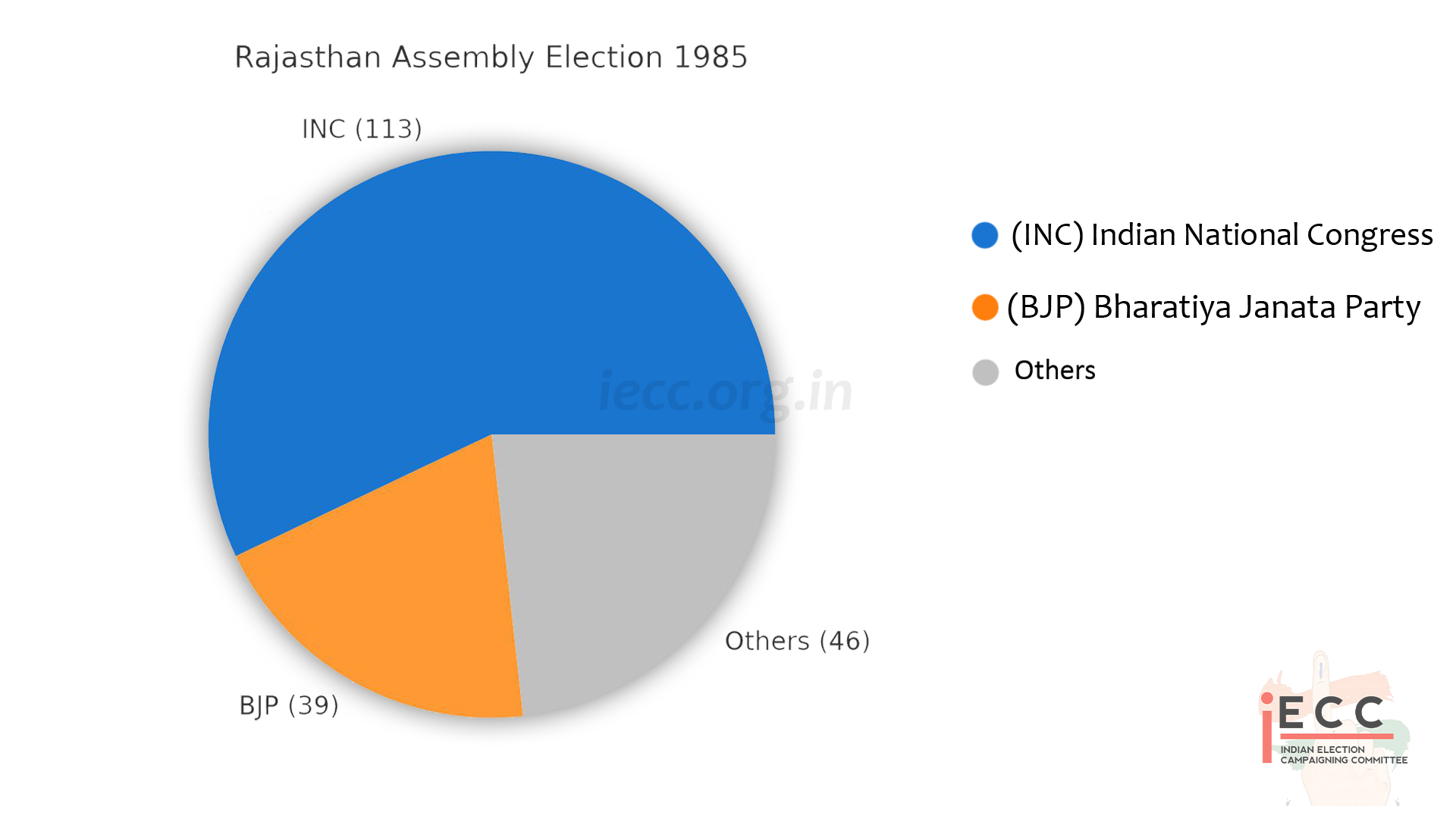
1990 Rajasthan Legislative Assembly Election Results
| 1990 Rajasthan Legislative Assembly Election Results | |||
|---|---|---|---|
| Sr. No. | Short Name | Full Name | Seats |
| 1 | BJP | Bharatiya Janata Party | 85 |
| 2 | Janata Dal | Janata Dal | 50 |
| 3 | INC | Indian National Congress | 50 |
| 4 | (Marxist) [CPI(M)] | Communist Party of India | 1 |
| 5 | Others / Independents | Others/Independents | 14 |
| Total | 200 | ||
The 1990 election came in the backdrop of anti-Congress sentiment, the Mandal Commission debate, and the rise of the BJP’s Ram Janmabhoomi movement.
The BJP (85 seats) and Janata Dal (50 seats) together secured a clear majority (135/200), defeating the Congress, which collapsed to just 50 seats — one of its worst performances in Rajasthan.
This election marked the first real breakthrough for the BJP in Rajasthan, as it became the largest party in the Assembly.
The Janata Dal, led by V.P. Singh nationally, also performed strongly and partnered with the BJP to form the government.
Bhairon Singh Shekhawat (BJP) became the Chief Minister of Rajasthan for the second time (first was briefly in 1977).
The Congress decline reflected a larger trend across North India in 1990, where voters turned towards BJP-Janata Dal alliances.
This election also marked the emergence of coalition politics in Rajasthan, a break from Congress’s earlier dominance

1993 Rajasthan Legislative Assembly Election Results
| 1993 Rajasthan Legislative Assembly Election Results | |||
|---|---|---|---|
| Sr. No. | Short Name | Full Name | Seats |
| 1 | BJP | Bharatiya Janata Party | 95 |
| 2 | INC | Indian National Congress | 76 |
| 3 | JD | Janata Dal | 3 |
| 4 | (Marxist) CPI(M) | Communist Party of India | 1 |
| 5 | Others / Independents | Others / Independents | 25 |
| Total | 200 | ||
The 1993 election was highly competitive between BJP and Congress.
The BJP emerged as the single largest party with 95 seats but could not secure a majority on its own.
The Congress secured 76 seats, lower than expected, showing a decline.
Independents (25 seats) became the deciding factor in forming the government.
Bhairon Singh Shekhawat (BJP), through support from Independents and smaller groups, was able to continue as the Chief Minister of Rajasthan

1998 Rajasthan Legislative Assembly Election Results
| 1998 Rajasthan Legislative Assembly Election Results | |||
|---|---|---|---|
| Sr. No. | Short Name | Full Name | Seats |
| 1 | INC | Indian National Congress | 153 |
| 2 | BJP | Bharatiya Janata Party | 33 |
| 3 | (Marxist) [CPI(M)] | Communist Party of India | 1 |
| 4 | Independents & Others | Independents & Others | 13 |
| Total | 200 | ||
The INC registered a landslide victory by securing 153 seats, a huge jump from its 76 seats in 1993.
The BJP faced a massive setback, dropping to just 33 seats from 95 in the previous election.
The INC’s campaign was focused on social welfare, rural development, and dissatisfaction with the Shekhawat-led BJP government.
Ashok Gehlot became the Chief Minister for the first time in Rajasthan.
This election highlighted the anti-incumbency trend of Rajasthan, where voters often switch governments after one term
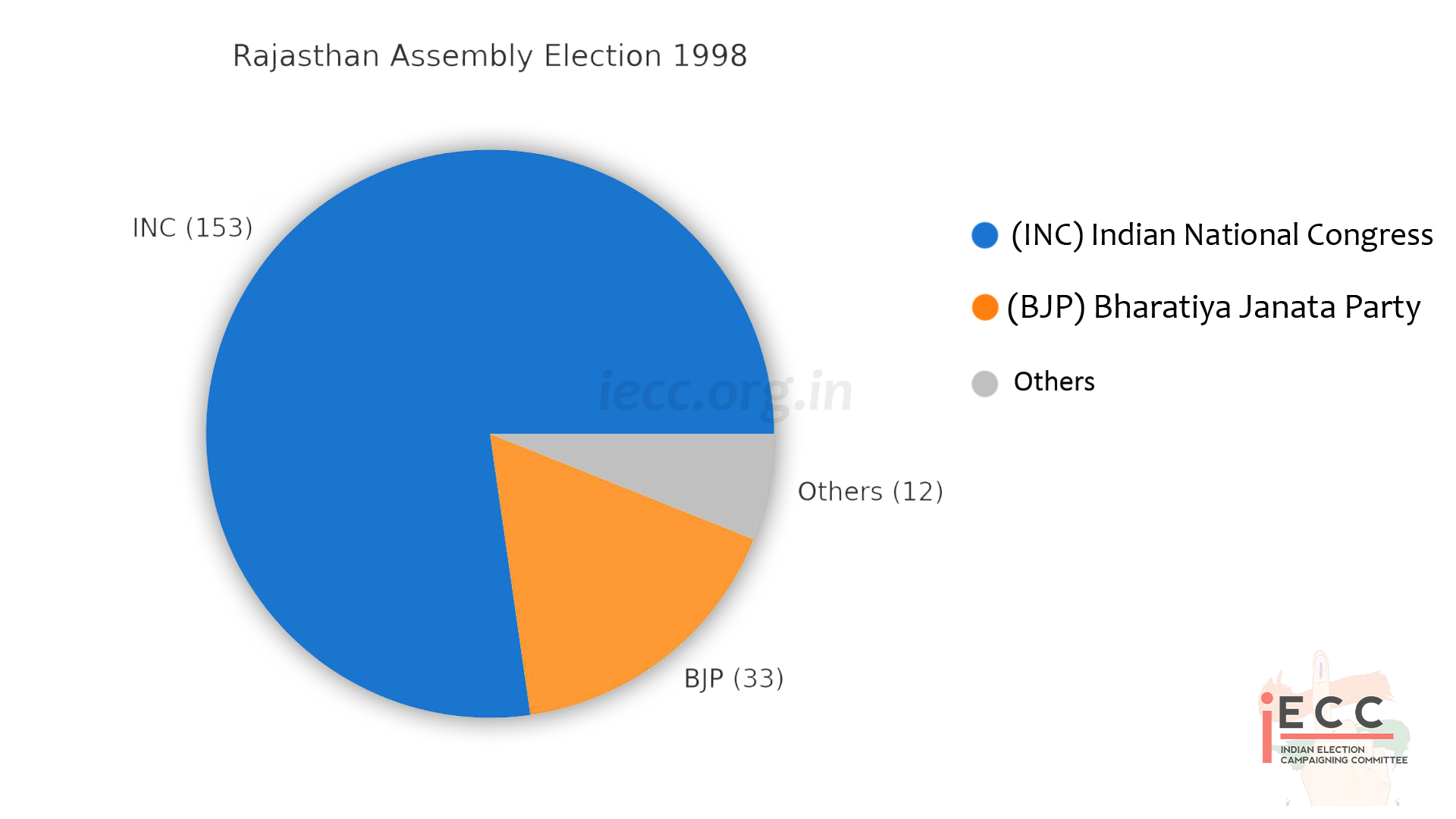
2003 Rajasthan Legislative Assembly Election Results
| 2003 Rajasthan Legislative Assembly Election Results | |||
|---|---|---|---|
| Sr. No. | Short Name | Full Name | Seats |
| 1 | BJP | Bharatiya Janata Party | 120 |
| 2 | INC | Indian National Congress | 56 |
| 3 | BSP | Bahujan Samaj Party | 2 |
| 4 | CPI | Communist Party of India | 2 |
| 5 | (Marxist) [CPI(M)] | Communist Party of India | 1 |
| 6 | Independents & Others | Independents & Others | 21 |
| Total | 202 | ||
The BJP secured a decisive majority with 120 seats, a major jump from just 33 seats in 1998.
The INC collapsed to 56 seats, losing its strong mandate from the previous election.
Vasundhara Raje became the first woman Chief Minister of Rajasthan.
The election reflected anti-incumbency against Ashok Gehlot’s Congress government, largely due to rural distress, unemployment, and dissatisfaction with governance.
BJP’s campaign focused on development, women empowerment, and leadership change, which resonated with voters

2008 Rajasthan Legislative Assembly Election Results
| 2008 Rajasthan Legislative Assembly Election Results | |||
|---|---|---|---|
| Sr. No. | Short Name | Full Name | Seats |
| 1 | INC | Indian National Congress | 96 |
| 2 | BJP | Bharatiya Janata Party | 78 |
| 3 | BSP | Bahujan Samaj Party | 6 |
| 4 | (Marxist) [CPI(M)] | Communist Party of India | 3 |
| 5 | Others / Independents | Others / Independents | 17 |
| Total | 200 | ||
The INC emerged as the single largest party with 96 seats, but fell short of the majority mark.
The BJP slipped to 78 seats, losing ground after ruling under Vasundhara Raje.
Smaller parties like BSP (6 seats) and CPI(M) (3 seats), along with Independents, held the balance of power.
With outside support from BSP and Independents, the INC formed the government.
Ashok Gehlot returned as Chief Minister for his second term.
The election results reflected anti-incumbency against Vasundhara Raje’s government, particularly over issues of inflation, farmer distress, law and order, and unemployment

2013 Rajasthan Legislative Assembly Election Results
| 2013 Rajasthan Legislative Assembly Election Results | |||
|---|---|---|---|
| Sr. No. | Short Name | Full Name | Seats |
| 1 | BJP | Bharatiya Janata Party | 163 |
| 2 | INC | Indian National Congress | 21 |
| 3 | BSP | Bahujan Samaj Party | 3 |
| 4 | NPP | National People’s Party | 4 |
| 5 | Independents & Others | Independents & Others | 9 |
| Total | 200 | ||
The BJP achieved a historic landslide victory, winning 163 out of 200 seats – one of its best-ever performances in Rajasthan.
The INC suffered its worst-ever defeat, crashing to just 21 seats, a massive fall from 96 in 2008.
Vasundhara Raje returned as Chief Minister for her second term.
Factors for BJP’s big win:
Strong anti-incumbency against Ashok Gehlot’s INC government.
Rising inflation, corruption allegations, unemployment, and poor law-and-order situation.
The growing popularity of Narendra Modi (then BJP’s PM candidate) added momentum
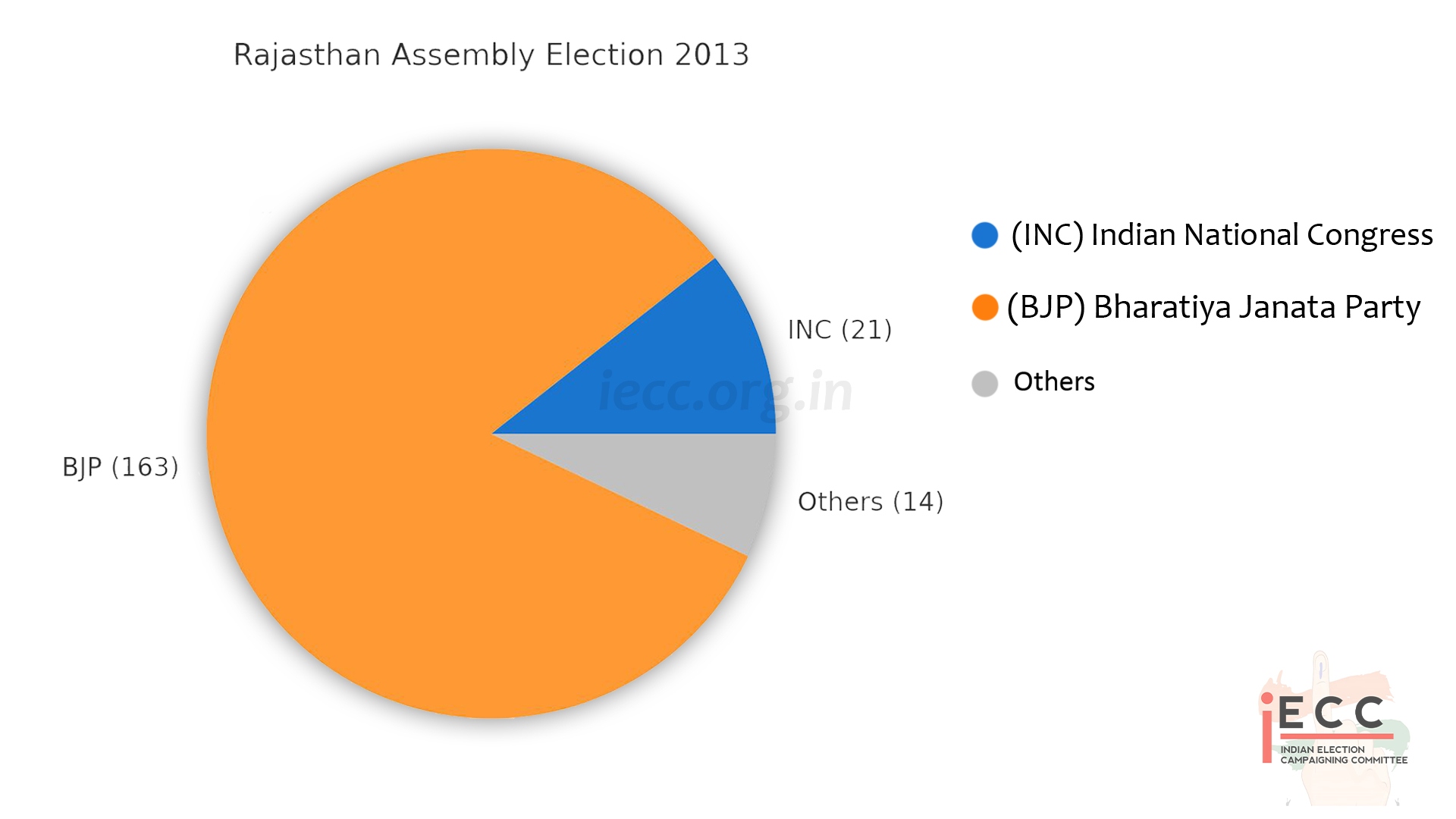
2018 Rajasthan Legislative Assembly Election Results
| 2018 Rajasthan Legislative Assembly Election Results | |||
|---|---|---|---|
| Sr. No. | Short Name | Full Name | Seats |
| 1 | INC | Indian National Congress | 100 |
| 2 | BJP | Bharatiya Janata Party | 73 |
| 3 | BSP | Bahujan Samaj Party | 6 |
| 4 | (Marxist) [CPI(M)] | Communist Party of India | 2 |
| 5 | RLP | Rashtriya Loktantrik Party | 3 |
| 6 | Independents & Others | Independents & Others | 15 |
| Total | 199 | ||
The INC emerged as the single largest party with 100 seats – just one short of a majority.
The BJP dropped to 73 seats, a major decline from its landslide 163 in 2013.
Smaller parties and Independents, especially BSP (6), RLP (3), and Independents (15), became crucial for government formation.
With support from BSP and Independents, INC formed the government.
Ashok Gehlot was chosen as Chief Minister, while Sachin Pilot (Rajasthan Congress President) became Deputy CM.
The result was driven by anti-incumbency against Vasundhara Raje, farmer distress, unemployment, and demands for better governance.
The election confirmed Rajasthan’s alternating power pattern, with voters replacing the ruling party every 5 years
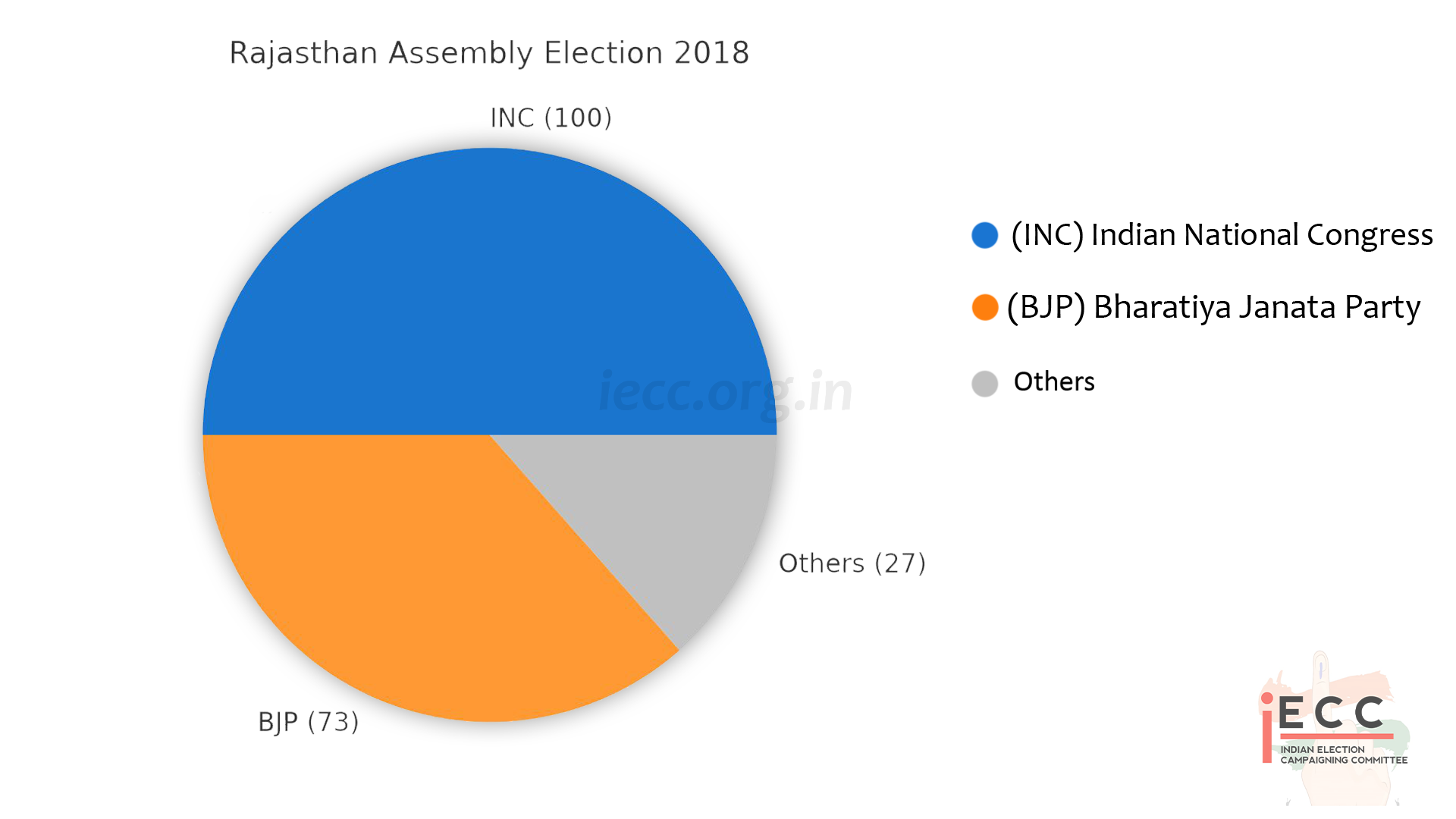
2023 Rajasthan Legislative Assembly Election Results
| 2023 Rajasthan Legislative Assembly Election Results | |||
|---|---|---|---|
| Sr. No. | Short Name | Full Name | Seats |
| 1 | BJP | Bharatiya Janata Party | 115 |
| 2 | INC | Indian National Congress | 139 |
| 3 | BAP | Bharat Adivasi Party | 3 |
| 4 | BSP | Bahujan Samaj Party | 2 |
| 5 | RLP | Rashtriya Loktantrik Party | 1 |
| 6 | RLD | Rashtriya Lok Dal | 1 |
| 7 | Independents | Independents | 8 |
| Total | 269 | ||
The BJP clinched a solid majority with 115 seats, ending five years of INC rule
The INC suffered a notable defeat, winning roughly 69–70 seats, confirming the enduring “revolving door” trend—Rajasthan voters frequently vote out incumbents
The BJP’s campaign strategy capitalized on issues such as corruption, law & order, paper-leaks, and leveraged Prime Minister Modi’s popularity
The Udaipur beheading case of 2022 critically hurt the Congress’s image, with former CM Gehlot admitting its impact on election results
BJP also made significant gains in SC/ST reserved seats, traditionally held by Congress and BSP
Smaller parties and independents (including BAP, BSP, RLP, RLD, and independents) collectively occupied a small yet pivotal number of seats

